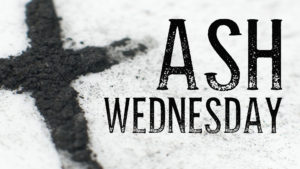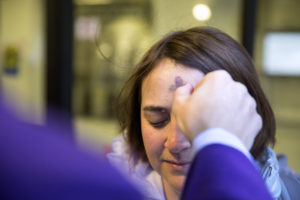 Ash Wednesday
Ash Wednesday
Ash Wednesday marks the beginning of the season of Lent. It falls 46 days before Easter, meaning it can be as early as February 4 or as late as March 10. For those who have always heard that Lent is 40 days, you are correct. That is because Lent is a fasting season and Sundays are always “feast” days, so Sundays don’t count. That is why we say “Sundays in Lent” and not “Sundays of Lent.” There are six Sundays “in” Lent leaving 40 days “of” Lent. That means that if you give something up for this Lent you can still do it on Sundays and not break your Lenten fast.
The use of ashes to visibly reflect a state of mourning and repentance dates back to Old Testament days (Numbers 19:9, 17; 2 Samuel 13:19; Esther 4:1; Job16:15; 42:3-6; Daniel 9:3; Jeremiah 6:26; Jonah 3:6) and is reflected also in the New Testament (Matthew 11:21; Luke 10:13; Hebrews 9:13). It is especially the accent on repentance of sin, found in the words of Jesus, which is carried over into the Christian tradition.
The early church theologian Tertullian (ca. 150-225) described the use of “sackcloth and ashes” in the penance of an adulterer. In the fifth century the early church fathers Eusebius, Cyprian, and Jerome also associated ashes with public repentance. The last of the early fathers, Isidore of Seville (ca. 560-636), described the practice of his day with these influential words: “It is good, therefore, that a penitent deplore his sin in sackcloth and ashes, for in sackcloth is harshness and the prick of sin; and the ashes, moreover, display the dust of death.”
These descriptions of the use of ashes to denote repentance do not associate the use of ash with the first day of Lent. My sources are conflicting about how early this association is made. One source says, “The name dies cinerum (day of ashes) … is found in the earliest existing copies of the Gregorian Sacramentary and probably dates from at least the eighth century.” Another source says, “The earliest clearly datable rite directly associated with the opening day of Lent … is AD 960, from a pastoral manual issued at Mainz, which became precedent for this practice. The practice had its Lenten origins in western Europe, rather than Rome.” Any way you slice it, Ash Wednesday was present before 1000 AD. In 1091, Pope Urban II at the council of Benevento, extended the practice to the church in Rome.
By the time of the Reformation many “abuses” had arisen in the Roman Catholic worship practices. Luther, and others, set out to reform the worship practices. The process in Lutheran efforts was, to put it in common terms, “IF it ain’t broke, don’t fix it,” and any fixing that had to be done was determined according to the article of justification by grace through faith. This ceremonial conservatism would consequently shape and inform Lutheran theology and practice, and preserve the catholic (universal Christian) heritage of the church among Lutherans, since they sought to be both “evangelical” (Gospel centered) and “catholic.” Liturgical scholar Frank Senn notes with regard to the imposition of ashes among Lutherans in the aftermath of the Reformation: “How and why the use of ashes fell out of Lutheran use is difficult to discern from the sources… [C]hurch orders don’t specifically say not to use ashes; they simply stopped giving direction for blessing and distributing them and eventually the pastors just stopped doing it.”
That it did fall out of general use is witnessed by the fact that, as I was growing up, we never used ashes on Ash Wednesday in my home church nor any other Lutheran Church of which I knew. Nonetheless, we did retain the name “Ash Wednesday.” For many years, only Roman Catholic churches used ashes on Ash Wednesday. Some non-Lutheran denominations even prohibited it. I guess it seemed too “Roman Catholic.”
The simple reality is that the use of ashes on Ash Wednesday has had an explosion of popularity in recent decades. It is now one of the most attended services across America, and many people who do not attend worship services any other time of the year attend on Ash Wednesday.
The question remains, though, “Should we use ashes on Ash Wednesday?” This practice is not present in the Scriptures. It is neither commanded nor prohibited. So what should we do as biblical Christians?
In his Pastoral Theology, C.F.W. Walther, first LCMS president, states that when it comes to ceremonies that are neither commanded nor forbidden, what at one time and place may be forbidden may at other times be used once again. Therefore, it is possible for Lutherans to use the imposition of ashes on Ash Wednesday if it doesn’t inhibit or obscure the clear teaching of justification by grace through faith. To put that another way, we are free to use the practice to teach the faith.
The imposition of ashes slipped out of Lutheran usage without much specific reflection or writing on the matter. Certainly Lutherans have gladly retained many other rites and ceremonies inherited from our rightful catholic (universal Christian) heritage and interpreted them “in an evangelical way.” Certainly we do not need to bring along the “baggage” of what was problematic in the Roman Catholic use of ashes (blessing them instead of the people, insisting they be from palms used on Palm Sunday, etc.). For instance, Luther commends in many places the use of the sign of the cross, something that dates back to the early church but not found in the Bible. The abuse of a practice or ceremony does not invalidate its proper use. Just because something can be misunderstood or abused doesn’t mean it should be abandoned or forbidden.
 The imposition of ashes for Ash Wednesday certainly makes better sense of the day’s actual name. Not using ashes on Ash Wednesday makes about as much sense as not celebrating the Lord’s Supper on Maundy Thursday. The traditional words of the rite are certainly drawn from Scripture (Genesis 3:19), and ashes are mentioned in numerous places in Scripture in connection with repentance – an outward sign of the inward fact. After all, our mortality (death) is a result of original sin, and the only way through death to life is by death to self and selfishness (sin as being “curved in toward one’s self”) that repentance brings. In this way, the imposing of ashes can teach of Christ and His benefits given in Baptism, as well as in Confession and Absolution. The mark of the cross with the ashes suggests a correlation between the penitential character of Lent (and Ash Wednesday) and the Lutheran focus on the passion of Christ. The ashes are a reminder of the death sentence upon mankind since Adam and Eve. By using this ceremony, we confess our agreement with God’s truthful verdict upon sin. Yet the ashes, in the shape of the cross, show that our sin is covered and atoned-for by the death of the Son of God. Of course, all this must be taught repeatedly.
The imposition of ashes for Ash Wednesday certainly makes better sense of the day’s actual name. Not using ashes on Ash Wednesday makes about as much sense as not celebrating the Lord’s Supper on Maundy Thursday. The traditional words of the rite are certainly drawn from Scripture (Genesis 3:19), and ashes are mentioned in numerous places in Scripture in connection with repentance – an outward sign of the inward fact. After all, our mortality (death) is a result of original sin, and the only way through death to life is by death to self and selfishness (sin as being “curved in toward one’s self”) that repentance brings. In this way, the imposing of ashes can teach of Christ and His benefits given in Baptism, as well as in Confession and Absolution. The mark of the cross with the ashes suggests a correlation between the penitential character of Lent (and Ash Wednesday) and the Lutheran focus on the passion of Christ. The ashes are a reminder of the death sentence upon mankind since Adam and Eve. By using this ceremony, we confess our agreement with God’s truthful verdict upon sin. Yet the ashes, in the shape of the cross, show that our sin is covered and atoned-for by the death of the Son of God. Of course, all this must be taught repeatedly.
Again, though, we need to remember that the use of ashes on Ash Wednesday is a choice. If we were commanded to use ashes on Ash Wednesday by some human authority, we would be conscience bound to not use them. It would be a testimony to our Christian freedom and that the use of ashes does not make one a Christian nor is it a Means of Grace. On the other hand, if we were commanded to not use ashes on Ash Wednesday, then we just might feel conscience bound to use them. Again it would be a testimony to our Christian freedom and that our salvation lies in Christ and not in some purely human prohibition. In other words, the use of ashes is like the use of liturgical colors on the altar.
We will be using ashes on Ash Wednesday as a symbol that we are sinners born under the just judgment of God and condemned to death. Yet they will be placed on our foreheads in the shape of a cross reminding us that we are redeemed by Jesus and therefore heirs of eternal life. A good Law-Gospel message.
Prayer: Almighty and everlasting God, You despise nothing You have made and forgive the sins of all who are penitent. Create in us new and contrite hearts that, lamenting our sins and acknowledging our wretchedness, we may receive from You full pardon and forgiveness; through Jesus Christ, Your Son, our Lord, who lives and reigns with You and the Holy Spirit, one God, now and forever. Amen.
Blessings in Christ,
Pastor John Rickert
If you like this post, why not share it?
